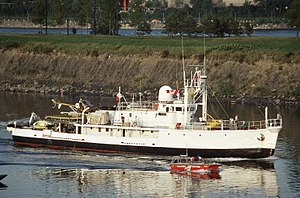 The research vessel Calypso of Jacques Cousteau arriving in Montreal on 30 August 1980
| |
| History | |
|---|---|
| Name | HMS J-826 |
| Builder | Ballard Marine Railway Company, Seattle, Washington, United States |
| Laid down | 12 August 1941 |
| Launched | 21 March 1942 |
| Commissioned | February 1943 |
| Recommissioned | BYMS-2026 (1944) |
| Decommissioned | 1946 |
| Renamed | Calypso G (1949) |
| Owner | Thomas Guinness |
| Operator | Compagnie Océanographique Française, Nice |
| Renamed | Calypso (1950) |
| Reclassified | Research vessel |
| Refit | For Cousteau (1951) |
| Fate | Sunk and raised (1996) |
| Status | Being refurbished under the direction of the Cousteau Society |
| General characteristics [1] | |
| Tonnage | 294 GRT |
| Displacement | 360 tons |
| Length | 139 ft (42 m) (43 meters, according to another source)[2] |
| Beam | 25 ft (7.6 m) |
| Draft | 10 ft (3.0 m) |
| Decks | Three |
| Installed power | 2 × 580 hp (430 kW) 8-cylinder General Motors diesel engines |
| Propulsion | Twin screw |
| Speed | 10 knots (19 km/h; 12 mph) |
| Crew | 27 in captain's quarters, 6 staterooms and crew quarters |
| Notes |
|
RV Calypso is a former British Royal Navy minesweeper converted into a research vessel for the oceanographic researcher Jacques Cousteau, equipped with a mobile laboratory for underwater field research. She was severely damaged in 1996 and was planned to undergo a complete refurbishment in 2009–2011 that has not been accomplished. The ship is named after the Greek mythological figure Calypso.
- ^ "Sea Sabres: The Calypso: The stories she could tell!". 23 July 2003. Archived from the original on 3 March 2016.
- ^ "Une pétition pour "sauver" la Calypso du commandant Cousteau". Le Point (in French). Agence France Presse. 7 October 2013. Retrieved 5 April 2016.